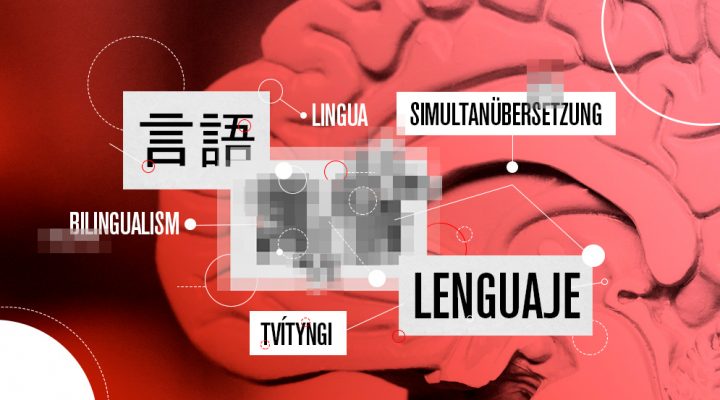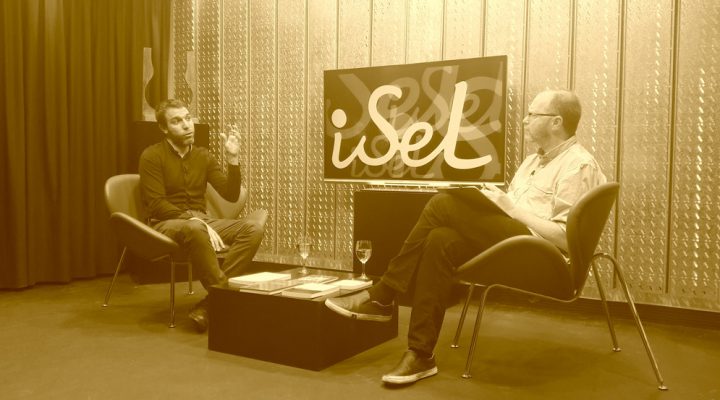SCIENCE & SOCIETY
What is the neuroscience of language?
The relationship between language and the brain as studied in Argentina.
The neuroscience of language is a branch of cognitive neuroscience, a field aimed to understand the relationship between our mental experiences and our biology, with emphasis on the brain in the context of our bodies. We, human beings, have many mental abilities that can be studied scientifically. Many researchers are interested in understanding the neurobiological bases of memory, or the origin of emotions or attention, and so on. Trying to understand how language —the ability to produce and comprehend language, to acquire a native tongue, or to learn a foreign language— relates to the brain is the task of the neuroscience of language.
Adolfo M. García is a researcher at the National Scientific and Technical Research Council of Argentina (CONICET) and he is a specialist in this field. During his academic training, he first obtained the degree of Technical-Scientific Translator in English, and then earned his major in Teaching of English as a Foreign Language. Originally, he developed a taste for general linguistics. Then, his curiosity took him deep into the world of neurolinguistics, in a journey that began with research stays at New York University and Rice University, both in the United States. In his doctorate, he combined two of his passions: translation and brain studies. Nowadays, he is the scientific director of the Laboratory of Experimental Psychology and Neuroscience (LPEN) at the Institute of Cognitive and Translational Neuroscience (INCYT), which belongs to the Ineco Foundation, Favaloro Foundation and CONICET.
Researchers in the neuroscience of language are also interested in knowing what happens in the brain when linguistic abilities are lost, be it due to an age-related decline or some form of brain pathology. These diseases may be acquired, such as the aphasias, or neurodegenerative, such as the Alzheimer’s disease or Parkinson’s disease, among others. “Basically, we seek to understand language in biological and, more precisely, neurobiological terms,” states García.
Researching language
Language is a diverse and complex phenomenon, so it can be studied in various ways. First of all, it can be studied through its products. For example, scientists can record samples of what people write or say, and infer what mental processes were involved in that production. Language can also be explored through behavioral evidence: “In a typical experiment, a person would sit facing a screen where different words are displayed. He or she has to press a key from the keyboard every time the appearing word fulfills a certain condition, for instance, belonging to a specific word category, such as verbs,” describes García.
In these kinds of experiments, two aspects can be analyzed: 1) accuracy, that is, the number of correct answers and 2) efficiency, the time required to perform the task. These studies may be combined with brain measurements: “As the participant performs the previous task, we can obtain electroencephalographic recordings. A special cap, typically with 64 or 128 electrodes, measures electrical brain activity while the participant processes each word,” García explains. The result is a very fine chronometry of when the process of interest took place, that is to say, when there was a specific peak associated with that process.
Behavioral tasks can also be combined with magnetic resonance imaging, a technique that shows which brain areas get more activated when performing a specific task. This approach is very useful in answering where-type questions, as it registers hemodynamic changes with high spatial resolution. The results obtained allow scientists to chart a cartography of language in the brain.
The different techniques and methods allow studying the multiple dimensions of the brain that are related to language. “There is no such a thing as a good or a bad technique; rather, each of them will prove more or less useful to answer the various scientific questions,” says the scientist.
The neuroscience of language in Argentina
García and his team have also explored the language abilities of patients with brain diseases through artificial intelligence “Some years ago, we started a collaboration with IBM’s Watson Center in New York. Together, we are working on the following project: We ask healthy people and patients with Parkinson’s disease to tell us a story, for instance, about what they do during an ordinary day. This is a free speech task, with no restrictions. We record all these narrations, transcribe them, and enter them on a computer program. Afterwards, we use artificial intelligence so that the computer ‘learns’ the typical characteristics of the narrations produced, for example, by healthy people, on the one hand, and by Parkinson’s disease, one the other.”
This way, scientists can train the computer to recognize the typical grammar and vocabulary that a patient with Parkinson’s disease uses. Once the computer learns such patterns, the researcher can feed a new text to the computer, and task it with the mission of detecting whether the person who wrote the new text has the disease or not. García shows enthusiasm: “We have been able to detect and automatically classify texts as belonging to healthy people or patients with Parkinson’s disease with roughly 80% accuracy. The intersection between language sciences and artificial intelligence allows us to find hints of particular diseases in brief samples of spontaneous discourse.”
These interesting findings show that everyday language can give us clues about the state of a person’s brain. As a result, it could be useful for detecting pathologies, by just analyzing normal speech. This method presents many advantages: a) the tests are noninvasive, so that they do not involve any type of intervention on the patient; b) they are inexpensive since scientists just need to record the patient’s voice and then enter the information in the algorithms; c) they are not tiresome for participants (as opposed to typical neuropsychological tests, which are usually long and tedious). Moreover, with only two or three minutes of audio recording, high-efficiency rates can be obtained. Neurodegenerative diseases do not have a cure yet, but, if they are detected on time, medical intervention can work better —for example, via motor or cognitive rehabilitation programs that can delay or lessen the impact of symptoms. “That’s why linguistic biomarkers can be really helpful,” García emphasizes.
Researchers at INCYT also study the neurocognitive aspects of bilingualism. For instance, how the experience of developing a second language, apart from the native tongue, impacts on our cognition; how a bilingual brain differs from a monolingual one, and which cognitive skills are boosted as a result of the bilingual experience. No less interesting is the question of how two or more languages are organized in a single brain: Are there specific brain areas for each language, or not? Do they use the same mechanisms? What happens inside the brain during a translation process?
“Within bilingualism, we also work with special populations, such as simultaneous interpreters, those professionals who do simultaneous interpretation at conferences. Simultaneous interpretation represents a very juicy model for understanding how our brain adapts to highly demanding processing conditions,” García specifies. Simultaneous interpreters carry out different tasks at the same time: they listen to what someone says in a language and, at the same time, translate it into another language. While they are translating, the other person continues speaking, so the interpreter must keep in memory what the other has just said. “This is a very difficult task! Thus, interpreters represent a model of expert bilingual processing. For example, we can measure if interpreters are ‘better’ than non-interpreter bilinguals in certain cognitive abilities,” García illustrates. These kinds of comparisons have shown that interpreters have hyper-developed certain lexical processing skills and their working memory skills, among others, as they train them constantly.
Educational applications
According to García and his team at INCYT, language is part of most of our experiences: “it is intertwined with our emotions, frustrations, movements, and memories. Our ordinary life is constantly molded by language in non-random ways.” This prompts the researchers’ interest in studying the links between language and our experience, as mediated by the brain. As language is an important part of our experience as humans, neurolinguistic studies have implications that are not only clinical but also educational. “In our lab, and in many more around the world, we have discovered that movement has a fundamental role in language.” In this sense, a theoretical discovery may also have educational applications.
“We performed an experiment in Australia where we took this hypothesis to the extreme —García narrates—. We worked with dyslexic children, who have difficulties in reading and other language skills. They had to listen to a story with lots of movement: the characters jump, run, clap their hands. Then, they were given a questionnaire tapping on their comprehension of the story. After that, they listened to another story whose characters are mostly still: they think, imagine, feel, but none of their movements are described. Thus, we have an action text and a non-action text.” The children answered 70% of the questions correctly for both questionnaires, which meant that the results were similar in both situations.
In the second part of the experiment, García had the children play Nintendo Wii games, which detect movement in three dimensions, for an hour and a half, during nine consecutive days. “They ended up all sweaty after putting their bodies in motion. After nine days of playful training, they were given again two texts: one with lots of action and the other one with virtually no action”. The researchers found that physical exercise selectively improved the children’s comprehension of the action text. “The key message of this study is: ‘Putting the body in motion helps you better understand the movements of the protagonists of the stories you read’,” he affirms.
According to the linguist, these findings are not capitalized on learning environments. “Classrooms are depriving themselves of a strong learning tool: putting the body in motion. Although it is very difficult to put this knowledge into practice, it shouldn’t fall on deaf ears. It’s a pity that there is not a more profuse dialogue between cognitive neuroscience and the field of education.”
Taking the neuroscience of language to society
In Garcia’s opinion, the duty of science does not end after the publication of scientific papers; rather, it goes beyond scientific spheres and into societal domains. “In our lab, we want to contribute to the social appropriation of science. We want to empower people with scientific knowledge,” he states. Thus, they regularly give public talks, write science dissemination books, and organize many other activities. “Last December, I launched a television program called De cerebros y palabras, which is dedicated to the relationship between brain and language”. García will host a series of interviews with different researchers, from Argentina and the world, who are specialized in the neuroscience of language. Language learning, language acquisition, the relationship between language and memory, language pathologies, and bilingualism, are but some of the topics to be addressed in this show.
Finally, scientific knowledge can reach society through formal education. “Recently, I had the honor of creating the Master’s in Language and Cognition at the National University of Cuyo. We are launching it in February 2020.” The master’s has two specializations: bilingualism and disorders of language. García shows enthusiasm: “It allows different disciplines to initiate a dialogue about two issues that are current and relevant. Also, all these initiatives help to multiply neurolinguistic knowledge throughout the nation, a worthy task in itself.”
Bibliographic reference:
García AM, Bocanegra Y, et al. (2017). Parkinson’s disease compromises the appraisal of action meanings evoked by naturalistic texts. Cortex 100, 111-126. DOI: https://doi.org/10.1016/j.cortex.2017.07.003
García AM, Muñoz E, Kogan B (2019). Taxing the bilingual mind: Effects of simultaneous interpreting experience on verbal and executive mechanisms. Bilingualism: Language and Cognition 1–11. DOI: https://doi.org/10.1017/S1366728919000063
Trevisan, P., Sedeño, L., Birba, A. et al. A moving story: Whole-body motor training selectively improves the appraisal of action meanings in naturalistic narratives. Scientific Reports 7, 12538 (2017) DOI: https://doi.org/10.1038/s41598-017-12928-w
By Jorgelina Martínez Grau

